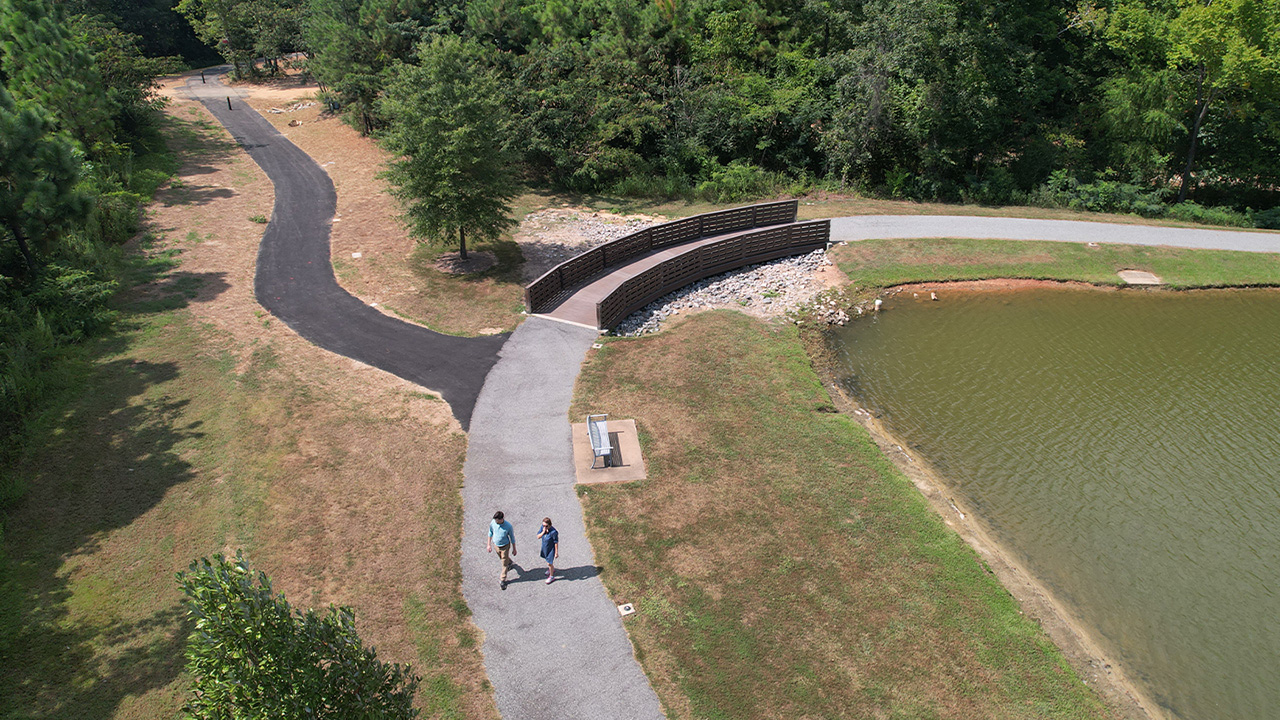content body
Whether you’re riding a bike, whizzing by on a scooter or traveling on foot, Auburn University faculty, staff and students have a new route to travel around campus.
Instead of fighting the traffic on busy South Donahue Drive, joggers, walkers and bicyclists can now go from Edward Via College of Osteopathic Medicine (VCOM) all the way to Auburn’s campus core on the Parkerson Mill Creek Greenway. The path, which was completed this past month, takes users from the Beard-Eaves-Memorial Coliseum past Auburn Recreation and Wellness’s Intramural Fields and Sportsplex through a wooded area to the lake behind VCOM.
The expansion was funded in part through a $1.2 million grant from the Alabama Department of Transportation (ALDOT), whose Transportation Alternative Program (TAP) funds infrastructure-related projects that provide safe routes for pedestrians, improve transportation options and enhance community members’ health and quality of life. Shared-use pathways like the Parkerson Mill Creek Greenway are valuable in part because they are accessible for so many types of non-motorized transportation.
The greenway has been developed by Auburn’s Facilities Management in three phases, the most recent of which was spearheaded by Design Project Manager Nikki Preston, Construction Project Manager Nick Blair and Assistant Director of Design Services Ben Burmester. While the connection between VCOM and central campus is an exciting development, Burmester is already thinking ahead to the possibility of someday going past VCOM.
“This phase of the Parkerson Mill Creek Greenway is a part of hopefully many future phases,” Burmester said. “While this phase takes it to a logical stopping point at the VCOM pond, it also sets up further extensions to the south toward Auburn Research Park as the next destination. Long-term, the trail could be extended all the way to Chewacla State Park.”
Shared-use paths and greenways have been shown to have environmental, economic, health and congestion-reduction benefits, so expanding the campus greenway system has numerous positive impacts. The Auburn campus continues to be primarily a pedestrian campus, and the Parkerson Mill Creek Greenway connects directly to the campus core’s bicycle and pedestrian infrastructure.
Burmester is pleased ALDOT sees the same value in the greenway as the university.
“We believed phase three of the Parkerson Mill Creek was a good candidate for the TAP funding as it connects two already highly used trails,” he said. “The Alabama Department of Transportation ultimately agreed and awarded the university the grant, and we are encouraged to see the newest section of the greenway already being used so much.”
What are people saying about the greenway?
Mike Kensler, director, Office of Sustainability:
“Greenways offer an abundance of benefits, starting with human access to natural settings for walking and biking. It is proven that access to nature improves our health and well-being. Greenways connect one part of a community with another, provide habitat, prevent soil erosion and filter stormwater, thereby protecting streams, and they beautify the community, just to name a few.
Scott Harper, director of facilities and operations, Recreation and Wellness:
“We are big fans of and supporters of the Parkerson Mill Greenway! As Auburn students traverse the expanded greenway, not only will they be able to enjoy a safe and beautiful tour of campus, but with regular usage, they can experience a wide variety of research-proven health benefits. Along with obvious physical health benefits, it’s a great way for students to gain improved social and mental benefits by walking, running or riding bikes together on their way to participate at the Recreation and Wellness Center, SportsPlex or intramural fields.”
Tom McCauley, associate director of environmental health & safety, Risk Management & Safety:
“From an environmental perspective, a greenway project connects people with the natural environment while also creating a managed buffer that serves to protect Parkerson Mill Creek from the unintended effects of development. With the addition of native vegetation and the greenway’s bridge crossings, this buffer helps to stabilize the streambanks from further erosion and sedimentation. As witnessed already along earlier phases, the greenway is used by many colleges to further academic enrichment through field study and reflects the university’s continued commitment of protecting and embracing the natural resources on campus.”
Eve Brantley, associate director, the Alabama Cooperative Extension System
“Auburn University’s commitment to managing water resources as an amenity serves as a real-world example of how communities may derive co-benefits from their streams and rivers. The Parkerson Mill Creek Greenway showcases recreational value along streams, connects people to their local stream and serves as an example of the innovations in stormwater and stream enhancement that are protective of stream health. Alabama Extension shares these innovations with students, faculty, staff and natural resource professionals from the state and region. We are excited to have this demonstration and outdoor classroom in our backyard that allow us to highlight research-based practices.”







